.
Administrative Region : North Aegean
Regional unit : Ikaria
Icaria, also spelled Ikaria (Greek: Ικαρία), is a Greek island in the Aegean Sea, 10 nautical miles (19 km) southwest of Samos. It derived its name from Icarus, the son of Daedalus in Greek mythology, who fell into the sea nearby. Administratively the island forms a separate municipality within the Ikaria peripheral unit, which is part of the North Aegean Periphery. The principal town of the island and seat of the municipality is Agios Kirykos.[1]
History
Ikaria has been inhabited since at least 7000 BC, when it was populated by the Neolithic pre-Hellenic people that Greeks called Pelasgians.
Artemis Tauropolos at Nas :
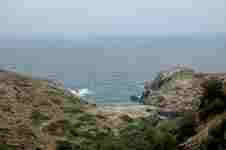
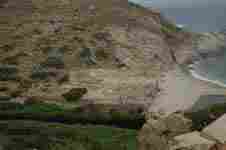
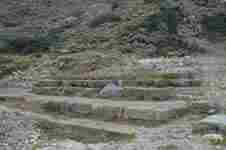
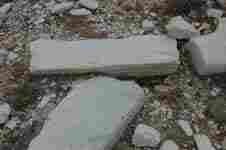
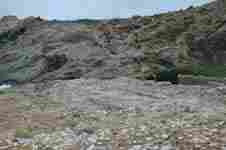
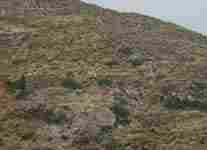
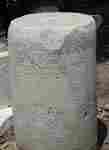
7,
Around 750 BC, Greeks from Miletus colonized Ikaria, establishing a settlement in the area of present day Campos, which they called Oenoe for its wine.
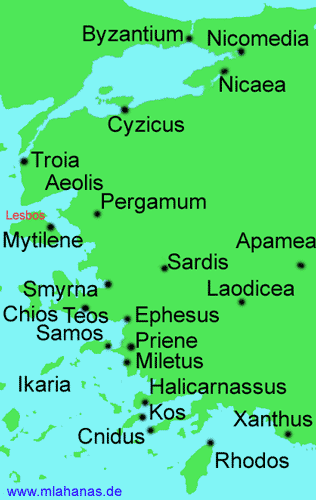
Ikaria, in the 6th century BC, became part of Polycrates' sea empire, and, in the 5th century BC, the Ikarian cities of Oenoe and Thermae were members of the Athenian-dominated Delian League. In the 2nd century, the island was colonized by Samos.[2] At this time, the Tauropolion,[3] the temple of Artemis was built at Oenoe. Coins of the city represented Artemis and a bull.[4] There was another, smaller temenos that was sacred to Artemis Tauropolos,[5] at Nas, on the northwest coast of the island.[6] Nas had been a sacred spot to the pre-Greek inhabitants of the Aegean and an important island port in antiquity, the last stop before testing the dangerous seas around Ikaria. It was an appropriate place for sailors to make sacrifices to Artemis Tauropolos, who, among other functions, was a patron of seafarers; here, the goddess was represented in an archaic wooden xoanon.
Fate of classical remnants
The temple stood in good repair until the middle of the 19th century when the marble was pillaged, for their local church, by the Kato Raches villagers. In 1939, it was excavated by the Greek archeologist Leon Politis. During the Axis occupation of Greece during World War II, many of the artifacts that were unearthed by Politis disappeared. Local custom states that there are still marble statues embedded in the sand off the coast.
Genoese era
Monastery in central Icaria.
In the 14th century Ikaria became part of a Genoese Aegean empire. At one stage, during this time, the Ikarians actually destroyed their harbors to deter the aggressive visitors.
According to local historians[CN], the Ikarians, left to their own devices, built seven watchtowers around the coast. As soon as a hostile or unknown sail was seen, the watchers immediately lit a fire and then ran to a cistern that was always filled with water. They pulled out a wooden bung in the bottom, and the water, of course, began to leak out. The garrisons of the other towers had been alerted by the fire to do the same thing at the same time.
Inside each cistern in each castle were identical lines, like those on a measuring jar. Each of these calibrations had a different message attached to it: "pirates attacking", "unknown sail approaching", etc.
When the water level reached the level of the appropriate message, the senders rebunged the cistern and put out the fire, and everyone in the other towers could determine the size and the proximity of the danger.
During this time, the Ikarians seldom built villages. Each house was remote from its neighbors, had one door, and was barricaded behind high walls. A working chimney could be a giveaway, so they endured smoke-filled rooms that were kept bare of lootable belongings: they hid their belongings in wall niches and slept on the floor.
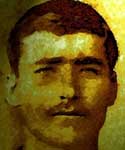
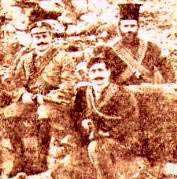
George Spanos of Evdilos, Ikarian Revolutionary Leaders
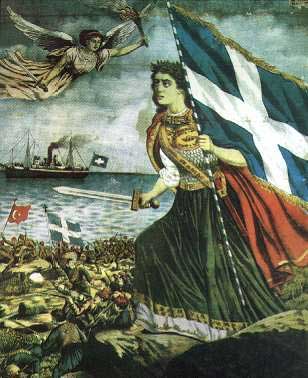
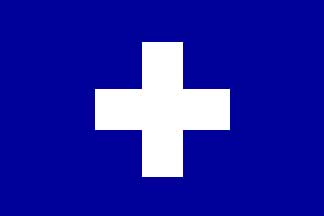
In Commemoration of Ikarian Revolution of 1912, Flag of the Free State of Ikaria (1912)
Ottoman Era
Further information: Ottoman Greece
The Knights of St. John, who had their base in Rhodes, exerted some control over Ikaria until 1521, when the Ottoman Empire incorporated Ikaria into its realm. The Ikarians hanged the first Turkish tax collector but managed to escape punishment, as none would identify the guilty one and the Turks realistically determined that there was neither profit nor honour in punishing all.[7]
Thanks in part to the island's primitive conditions and poverty, the Turks imposed a very loose administration, not sending any officials to Ikaria for several centuries. The best account we have of the island during these years is from archbishop J. Georgirenes who in 1677 described the island with 1,000 hardy, long-lived inhabitants, who were the poorest people in the Aegean.[8] Without a port, the island depended for its very limited intercourse with the outside world on small craft that were drawn up on the beaches, for which Icarian boat-builders had a high reputation, building boats from the abundant fir forests; they sold botas and lumber for coin and grain at Chios. The inshore waters, Georgirenes asserted, provided the best cockles in the Archipelago. Goats and sheep roamed virtually untended in the rocky landscape. Cheeses were made for consumption in each household. Ikarios in the 17th century was unusual in the Archipelago in not providing any wine for export; rather than keeping the wine made for local consumption in barrels, they continued to store it in the age-old fashion, in terracotta pithoi sunk to their rims in earth.
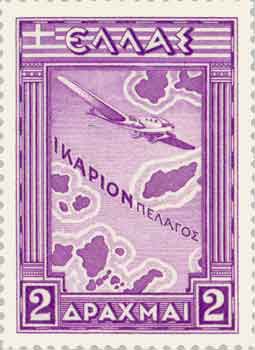
Icarian Sea
Apart from three small towns, none of which exceeded 100 houses,[9] and numerous village settlements, each house had a walled orchard and a garden plot. Unlike the closely built towns of Samos, the hardy inhabitants lived separately in fortified unfurnished farmsteads. They slept without bedding and wrapped themselves in their clothing. They often lived to great ages.[10] They admitted no strangers, and strictly married among themselves.
The ruins of the lighthouse on the promontory that faces Samos, called the "Tower of Icarus", were strictly off limits to the islanders, as tradition asserted that there was treasure to be found in them.[11]
In 1827, during the Greek War of Independence, Icaria broke away from the Ottoman Empire, but was not included in the narrow territory of the original independent Greece and was forced to accept Turkish rule once more a few years later.[CN]
Free State of Icaria
Flag of the Free State of Icaria (1912), similar in shape to the Flag of Switzerland.
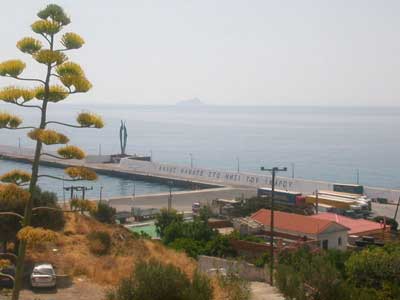
Main Harbour with Icarus monument
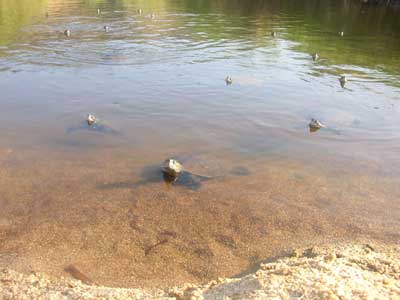
Livadi, Turtles
It remained part of the Ottoman Empire until July 17, 1912 when the Ikarians expelled a Turkish garrison and thereby achieved independence.[CN]
George Spanos (c.1872-1912) of Evdilos, killed in a Turkish ambush on that July 17, is honored as the hero of the Icarian Revolution. His bust, depicting him defiantly, with bandoliers and rifle in hand, may be seen in the National Resistance Square in Evdilos.
On July 18, 1912, the Free State of Icaria was declared. The neighboring islands of Fournoi Korseon were also liberated and became part of the Free State. Ioannis Malachias was the only president of the short-lived nation.
For five months, it remained an independent state, with its own armed forces, flag, stamps, and anthem. These five months were difficult times. There were food shortages, the people were without regular transportation and postal service, and they were at risk of becoming part of the Italian Aegean Empire.[CN] But in November 1912, after a delay due to the Balkan Wars, Icaria became part of Greece.
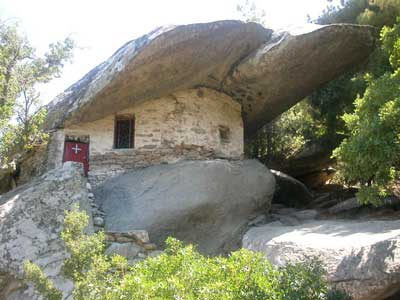
Church in Icaria
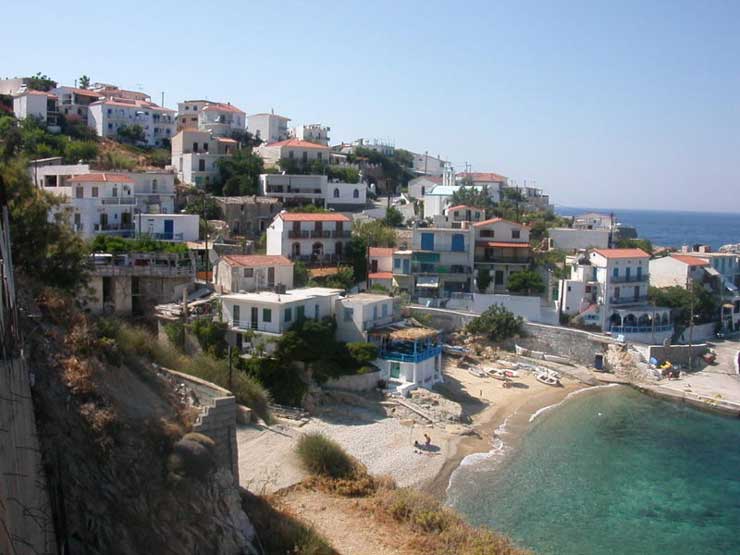
Armenistis, Ikaria
Second World War occupation and starvation
See also: Axis occupation of Greece during World War II
The island suffered tremendous losses in property and lives during the Second World War as the result of the Italian and then German occupation. There are no exact figures on how many people starved, but, in the village of Karavostamo alone, over 100 perished from starvation.
Red Rock
After the ravages of the war the nationalists and communists fought in the Greek Civil War (1945–1947), after which the Greek government used the island to exile about 13,000 communists. To this date, many of the islanders have remained sympathetic to communism, and, for this reason, Ikaria is referred to by some as the Kokkino Nisi (Greek: Κόκκινο νησί) (Red Island) or the Kokkinos Vrahos (Greek: Κόκκινος Βράχος) (Red Rock).
In his analysis, "Rebels and Radicals; Icaria 1600-2000", historian Anthony J. Papalas (East Carolina University) examines modern Icaria in the light of such 20th-century questions as poverty, emigration to America, the nature of the Axis occupation, the rise of Communism, the Civil War and the rightwing reaction to radical post-war movements.
Modern Era
The quality of life improved greatly after 1960 when the Greek government began to invest in the infrastructure of the island to assist in the promotion of tourism. Today, Icaria is considered one of the world's five "Blue Zones" - places where the population regularly lives to an advanced age (one in three make it to their 90s).[12]
In 2002 Greek authorities captured Ikarian-born, Christodoulos Xiros, a member of Revolutionary Organization 17 November.[13][14] A 58-year-old professor and economist, Alexandros Giotopoulos, was identified as the group's leader and was arrested on the nearby island of Lipsi.[15]
Geography
The village of Armenistis.
It is one of the middle islands of the northern Aegean, 255 km² (99 mi²) in area with 102 miles (160 km) of coastline and a population of 8,312 inhabitants. The topography is a contrast between verdant slopes and barren steep rocks. The island is mountainous for the most part. It is traversed by Aetheras range, whose highest summit is 1,037m. Most of its villages are nestled in the plains near the coast, with only some of them on the mountains. Icaria has a tradition in the production of strong red wine. Many parts of the island, especially the ravines, are covered in large bushes, making the landscape lush with green. Aside from domestic and domesticated species (small goat herds make their presence known with their bells, disturbing the serenity of the island) there are a number of small wild animals to be found, such as martens, otters, jumping spiders and toads. Icaria exhibits a typical Mediterranean climate.
Municipality
The present municipality Ikaria was formed at the 2011 local government reform by the merger of the following 3 former municipalities, that became municipal units:[1]
Agios Kirykos
Evdilos
Raches
Icarian Dance Group
Street in Raches village.
Notable people
Eleftheria Arvanitaki (1957) singer
Apostolos Kratsas politician (married to Rodi Kratsa-Tsagaropoulou vice pr. of european parliament)
Ilias Kratsas (born 1946) Director of Daihatsu Australia
Aris Poulianos (1924) anthropologist
Stan Gronthos (April 11, 1963) professor of stem cell research
Mikis Theodorakis (lived several years on the island as exiled)
Konstantinos Mendrinos (born 28 May 1985) football player
Stephan Pastis (born January 16 1968) cartoonist
Gerasimos Andreatos singer
Anargiros Frangos (June 30, 1927) Apollo Program Engineer
References
^ a b Kallikratis law Greece Ministry of Interior (Greek)
^ Graham Shipley, A History of Samos, c 800-188 B.C. (Oxford) 1987:205.
^ Strabo (xiv.1.19) gives the temple name Tauropolion
^ Barclay V. Head, Historia numorum: a manual of Greek numismatics vol. 2, no. 602, with legend ΟΙ or ΟΙΝΑΙ[ΩΝ], noted by Croon 1961:note 4.
^ for the aspect of Artemis that was associated with the Tauri, a people living near the Black Sea in the Crimean peninsula, see the article Brauron; that connection underlies the Iphigenia in Aulis of Euripides
^ Two sites are distinguished in J. H. Croon, "Hot Springs and Healing: A Preliminary Answer" Mnemosyne, Fourth Series, 14.2 (1961:140-141).
^ Georgirenes 1677:
^ Joseph Georgirenes, A Description of the Present State of Samos, Nikaria, Patmos, and Mount Athos (London 1677) pp 54-70; Georgirenes is the source for the summary of traditional culture that follows.
^ Georgirenes' Cachoria, Steli, famous for its nut-trees, and Musara, with its church containing relics of Saint Theoctistes of Lesbos; the Byzantine ruins remained of a larger town than any existing village (Georgirnes 1677:58).
^ "it being an ordinary thing to see persons in it, of an 100 years of Age, which is a great wonder, considering how hardily they live." (Georgirenes 1677:61).
^ Georgirenes 1677:57
^ http://www.npr.org/templates/story/story.php?storyId=103744881
^ ekathimerini.com | 20th N17 suspect held
^ Στο εδώλιο η 17Ν
^ "Greek leader hails anti-terror arrests". BBC News. 2002-07-19. Retrieved 2008-03-27.
| Ancient Greece
Science, Technology , Medicine , Warfare, , Biographies , Life , Cities/Places/Maps , Arts , Literature , Philosophy ,Olympics, Mythology , History , Images Medieval Greece / Byzantine Empire Science, Technology, Arts, , Warfare , Literature, Biographies, Icons, History Modern Greece Cities, Islands, Regions, Fauna/Flora ,Biographies , History , Warfare, Science/Technology, Literature, Music , Arts , Film/Actors , Sport , Fashion --- |
Retrieved from "http://en.wikipedia.org/"
All text is available under the terms of the GNU Free Documentation License



